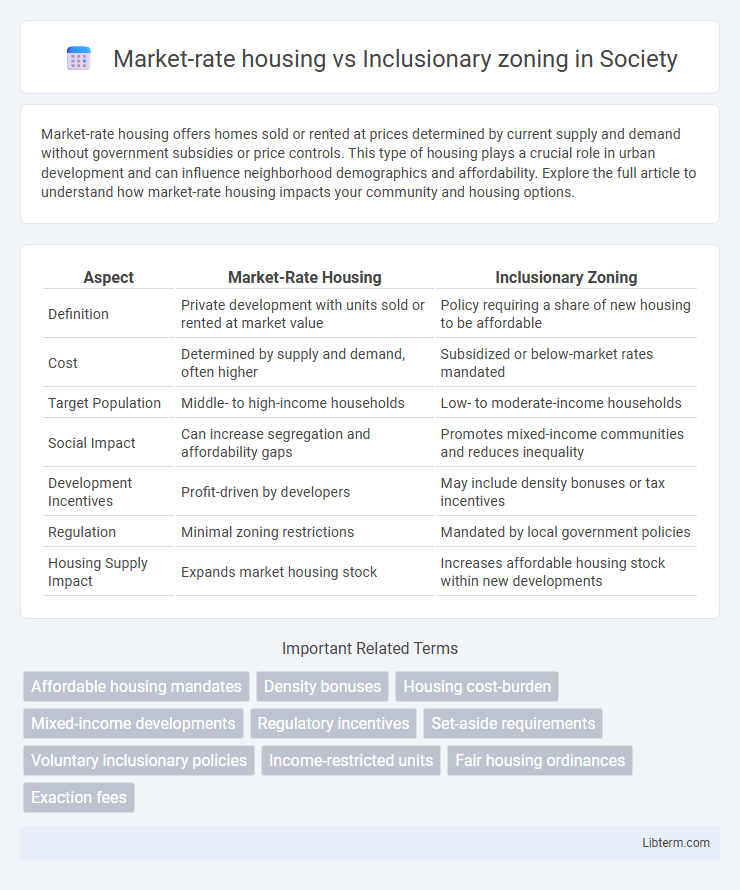Market-rate housing offers homes sold or rented at prices determined by current supply and demand without government subsidies or price controls. This type of housing plays a crucial role in urban development and can influence neighborhood demographics and affordability. Explore the full article to understand how market-rate housing impacts your community and housing options.
Table of Comparison
| Aspect | Market-Rate Housing | Inclusionary Zoning |
|---|---|---|
| Definition | Private development with units sold or rented at market value | Policy requiring a share of new housing to be affordable |
| Cost | Determined by supply and demand, often higher | Subsidized or below-market rates mandated |
| Target Population | Middle- to high-income households | Low- to moderate-income households |
| Social Impact | Can increase segregation and affordability gaps | Promotes mixed-income communities and reduces inequality |
| Development Incentives | Profit-driven by developers | May include density bonuses or tax incentives |
| Regulation | Minimal zoning restrictions | Mandated by local government policies |
| Housing Supply Impact | Expands market housing stock | Increases affordable housing stock within new developments |
Understanding Market-Rate Housing
Market-rate housing refers to residential properties priced according to current market demand without government subsidies or pricing controls, reflecting true supply and demand dynamics. These units often attract higher-income residents due to their cost, influencing neighborhood demographics and market values. Developers favor market-rate housing for profitability, but this can limit affordable housing availability and exacerbate socio-economic disparities.
Defining Inclusionary Zoning
Inclusionary zoning is a regulatory approach requiring developers to allocate a specific percentage of new housing units as affordable for low- to moderate-income households, contrasting with market-rate housing that is sold or rented at prevailing market prices without affordability restrictions. This policy aims to increase affordable housing stock within diverse communities, promoting socioeconomic integration and addressing housing shortages. Inclusionary zoning programs vary by locality but typically mandate affordability periods lasting 15 to 99 years, ensuring long-term impact.
Key Differences Between Market-Rate Housing and Inclusionary Zoning
Market-rate housing is developed primarily for profit, reflecting current real estate market demand and pricing, whereas inclusionary zoning mandates a percentage of new residential developments be affordable to low- and moderate-income households. Market-rate housing often leads to higher housing costs due to supply and demand dynamics, while inclusionary zoning aims to increase affordable housing stock within mixed-income communities. Key differences include regulatory requirements, affordability goals, and the impact on housing diversity and accessibility.
Economic Impacts on Communities
Market-rate housing typically drives economic growth by increasing property values and expanding the tax base, but often accelerates displacement and reduces affordability in lower-income communities. Inclusionary zoning mandates affordable units within new developments, promoting economic diversity and mitigating housing insecurity while potentially slowing development pace and raising costs for some market-rate projects. Balancing these approaches is crucial for sustainable community growth, as market-rate housing fosters investment and inclusionary zoning ensures equitable access to housing opportunities.
Affordability and Housing Accessibility
Market-rate housing often leads to higher prices that limit affordability and accessibility for low- to moderate-income households. Inclusionary zoning policies require developers to allocate a percentage of new units as affordable, directly increasing access to housing for diverse income levels. This approach balances market forces with social equity, promoting more inclusive community development.
Effects on Neighborhood Diversity
Market-rate housing often leads to homogenous neighborhoods due to higher income residents dominating the area, reducing socioeconomic diversity. Inclusionary zoning policies require a portion of new developments to be affordable, promoting diverse income groups and enhancing social integration. Studies show inclusionary zoning increases access to quality amenities and reduces segregation compared to purely market-rate housing developments.
Developer Perspectives and Challenges
Market-rate housing projects often yield higher short-term profits for developers due to fewer regulatory constraints and lower upfront costs. Inclusionary zoning policies require developers to allocate a percentage of units for affordable housing, potentially reducing overall profitability and complicating project financing. Navigating these challenges demands strategic balancing of social mandates with economic viability to sustain development momentum.
Policy Effectiveness and Outcomes
Market-rate housing often leads to faster development but may worsen affordability issues due to supply-demand imbalances, while inclusionary zoning policies require developers to allocate a percentage of units as affordable, promoting socioeconomic diversity. Studies show inclusionary zoning can increase affordable housing stock without significantly deterring overall construction, though effectiveness varies by local market conditions and implementation design. Outcomes indicate that well-crafted inclusionary zoning balances market growth with affordable access, whereas market-rate development alone risks heightened displacement and exclusion.
Case Studies: Successes and Failures
Case studies reveal that market-rate housing developments often struggle to provide affordable units without incentives, leading to limited socioeconomic diversity. Inclusionary zoning policies in cities like San Francisco and New York have successfully increased affordable housing stock but face challenges such as reduced overall development volume and increased costs for developers. Comparative analyses underscore the importance of tailoring inclusionary zoning mandates to local market conditions to balance housing affordability with sustainable development.
Future Trends in Housing Policy
Future trends in housing policy indicate a growing emphasis on inclusionary zoning to address the affordability crisis, promoting mixed-income communities by mandating developers to include a percentage of affordable units in market-rate projects. Advances in data analytics and urban planning technologies enable policymakers to tailor zoning regulations that balance market-rate housing supply with affordable housing needs, reducing socio-economic segregation. Increasing political support and community advocacy are driving legislative reforms to incentivize inclusionary zoning, aiming to create sustainable, equitable housing ecosystems in rapidly urbanizing areas.
Market-rate housing Infographic

 libterm.com
libterm.com